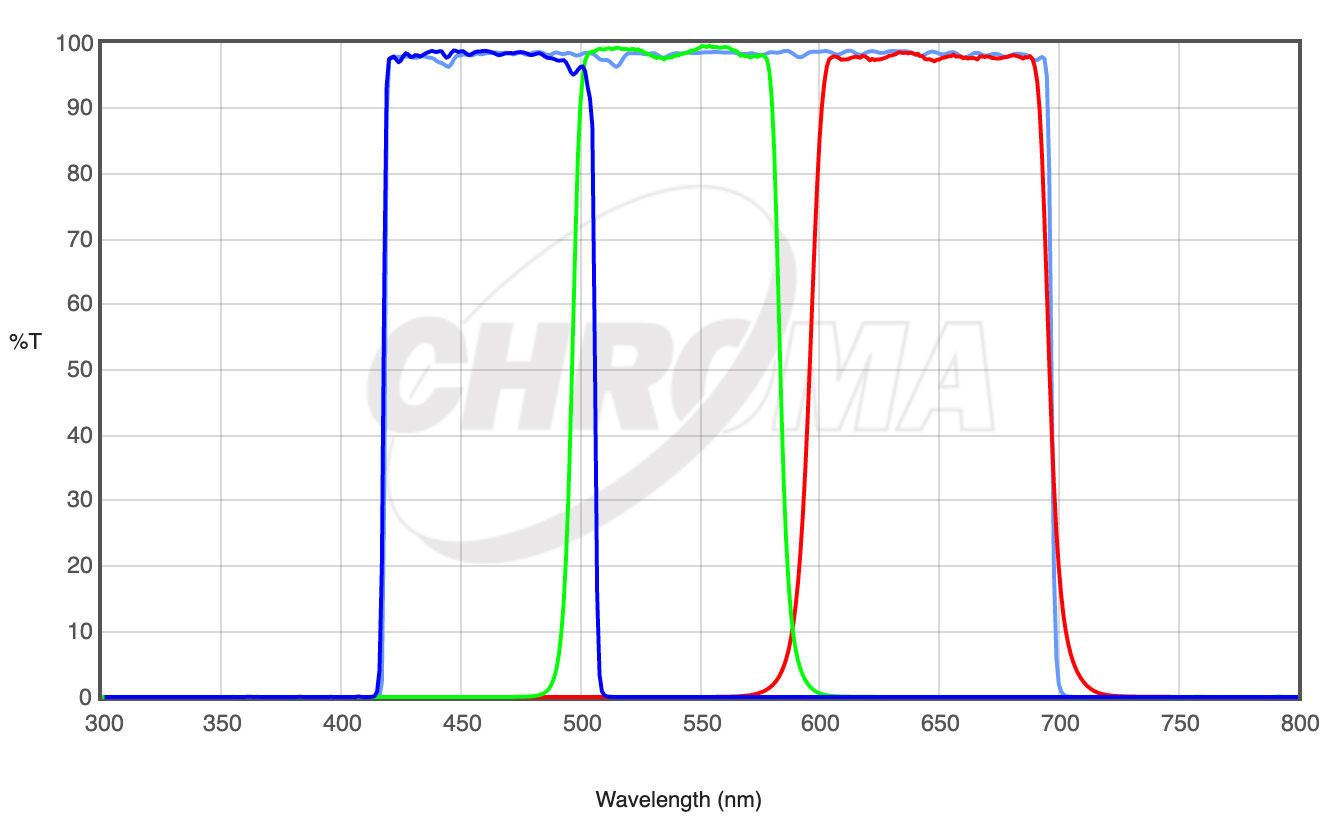About this product
Model: chroma_lrgb_36
Part Number: CT-27101-36D
Premium quality LRGB filter sets
Chroma’s complete LRGB filter sets include four individual filters - luminance, red, green, and blue.
Chroma Technology is an employee-owned company based in Vermont, USA. Chroma manufacture the highest quality astronomy filters with durable, sputtered hard coatings using single substrates of the best glass, eliminating the need for laminations. All primary filter coatings are applied on the front surface and anti-reflection coatings on the rear surface to prevent ghosting and to maximise transmission. Chroma astronomical filters are used worldwide in research and amateur applications.
Highly precise and accurate, the passbands of these filters remain spectrally stable and do not drift in response to extreme temperature fluctuations or changes in humidity.
All filters may be used with focal ratios of f/4 or slower. For optics faster than f/4 then due to the spectral shift we recommend using the 5nm filters instead.
FEATURES
- Durable sputter coatings
- Parallelism: <30 arcsec
- Thickness: 3.0 +/-0.05mm
- Filters designed for use with CCD and for f/4.0 or slower
- Transmitted wavefront better than 0.25 waves/inch
- No reflections leading to image distortions or ‘back reflections’
Transmission Chart

Cleaning and Handling
Handle coated pieces by the edges only. Clean gently only if necessary. Loose particles should be removed with a bulb puffer or filtered, pressurised air cleaner. If necessary, gently wipe surface using anhydrous alcohol and lint-free lab towels. Use new surface of towel with each wipe.
- AVOID TOUCHING OR WIPING A/R COATED OR METAL MIRROR SURFACES
- AVOID HANDLING EXPOSED COATINGS WITH BARE FINGERS
Orientation Instructions
Proper orientation of the filter is necessary in order to minimise autofluorescence and maximise performance. There is a caret (arrow) located on the edge of each filter in order to aid orientation. Excitation (x) filters should be positioned with the arrow pointing toward the specimen, toward the inside of the cube, and away from the light source. Emission (m) filters should be placed with the arrow pointing toward the specimen, toward the inside of the cube, and away from the detector/eye. Dichroic mirrors should be mounted with the coated surface toward the light source, excitation filters, and the specimen. The dichroics either have an arrow on the side pointing to the coated side, or they are beveled on the coated side. The beveled side is the smaller surface.
Customer reviews
| Average Rating (1 Review): | |
19 May 2021 | Alan
Hope this review helps anyone with the same type of problem. I have struggled for a year with Astronomik LRGB. I was getting hot spots on my LRGB ccd images especially L and G. Astronomik narrowband 6nm seemed ok by comparison. I scoured star gazer lounge forums for answers with little success. The ring like circular gradients were on the flats too but did not get rid of them after calibration. I got some good images in the end but not without cropping and extensive gradient removal. I deduced it was either the filters, internal reflections in the imaging train or the camera (SX 694 mono) or a combination of them. In the astrophotographer's off season i.e. now I decided to attempt to solve this. I splashed out on a full set of 1.25" Chroma filters, LRGB and 5nm Ha, 3nm O3, 3nm S2. Yes, very expensive but from my research they appeared to be very good. I took off my Skywatcher Esprit field flattener, spacer, Filterwheel and camera and any shiny black anodised surface I painted matt black (tried humbrol matt black enamel which dried gloss so used Rustins which was far better). I changed the filters and reassembled for testing on M13 LRGB and NGC7000 LHaO3S2 (Cygnus only at 35 degrees elevation at present but it was a test). Added a 1mm spacer Camera side to account for the 3mm filter thickness vs 1mm Astronomiks. Conclusion: WOW. Hot spots gone. I really did not expect this. All test subs really nice and flat. NGC7000 on L WOW. What I cannot say is was it the matt black or the filters or both? I thought light pollution was adding to my misery but no (although I have gone to enormous lengths to reduce it). So what seemed unsolvable to me is solved. I look forward to the new imaging season. Astrophotography is a very challenging hobby but it's great. The Chroma filters are extremely good quality and a worthy upgrade despite their cost.
FAQ
Please fill in the form below to ask a question.